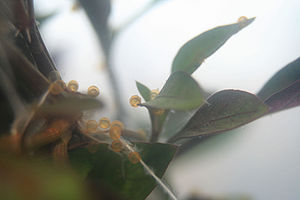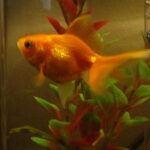It’s three in the morning. You can’t sleep because the goldfish are chasing each other, kicking up gravel and tearing up decorations. You consider hiring an exorcist. Your goldfish are possessed, not by evil spirits but by the urge to spawn. Goldfish that live in ponds tend to only spawn in spring or summer, but healthy fish kept in temperature-controlled tanks means that the spawning urge can come year round.
Even if you do not plan on breeding your goldfish, it’s still helpful to familiarize yourself with goldfish spawning behavior. This will help you to decipher when your fish is feeling sick – or just horny.
When They’re Ready
According to “Goldfish: A Complete Pet Owner’s Manual” (Marshall Ostrow; 1995), goldfish need to be about a year old before they will begin engaging in spawning behavior. Both males and females may get a richer, deeper or more brilliant coloration. Goldfish with elaborate head bumps may get larger and develop a deeper or more brilliant color.
Male fish will also grow tiny white bumps around their gills. These bumps are known as breeding tubercles. Although they are very small, they still can be seen with the naked eye in the rare times the male goldfish stays still. Breeding tubercles should not grow any white fuzz.
Rising water temperatures triggers spawning behavior in goldfish. The water needs to be at least 65 – 68 degrees Fahrenheit.
They’re At It Again!
Males chase females aggressively, but the females often stop suddenly as if they want to be caught. All of the males in the tank will pursue the female as she releases her eggs haphazardly into the water. She will often go into areas of bushy plants or floating plants so that the eggs will stick to the plants. The males then release their milt just as haphazardly. You may not be able to see either the eggs or the milt.
Males will bump their noses into the female’s side up near the gills. This can look aggressive at times, especially if two or more excited males bob the female’s sides. She may turn on her side as a response, but at no point should she bleed or float.
Males and females will often seem to ricochet around the tank at amazing speeds. Be sure to check for damage to the tank walls during and after spawning. Sometimes goldfish can spawn for as little as two hours, but often it can go on for days, with a few hours to rest in between sessions.
Parental Care
Goldfish are not the best parents. During spawning, they will begin to eat the eggs. Any fish in the tank not engaged in spawning behavior will also begin eating the eggs. Eggs will also be sucked up by most filtrations systems. This does prevent you becoming buried in goldfish, but if you do want to breed goldfish, you need to set up a separate breeding tank and remove the adults as quickly as possible after they are through spawning. It’s amazing this species has survived for so long.







